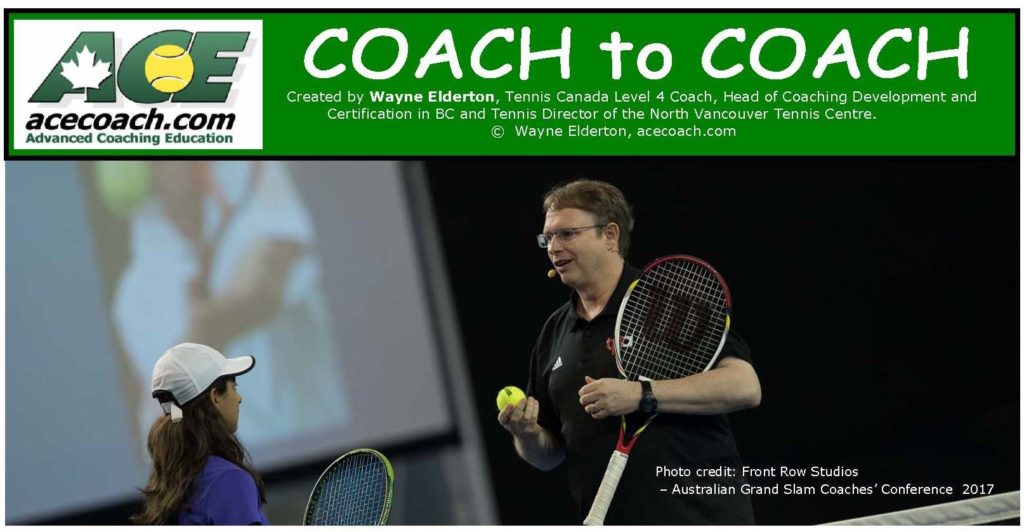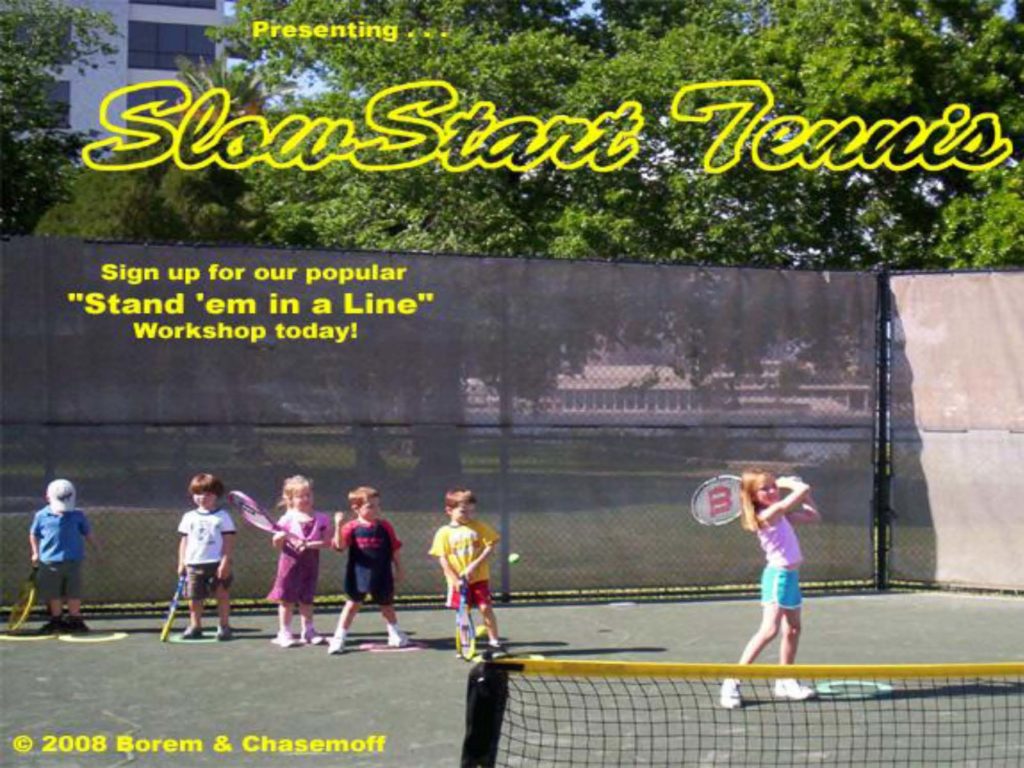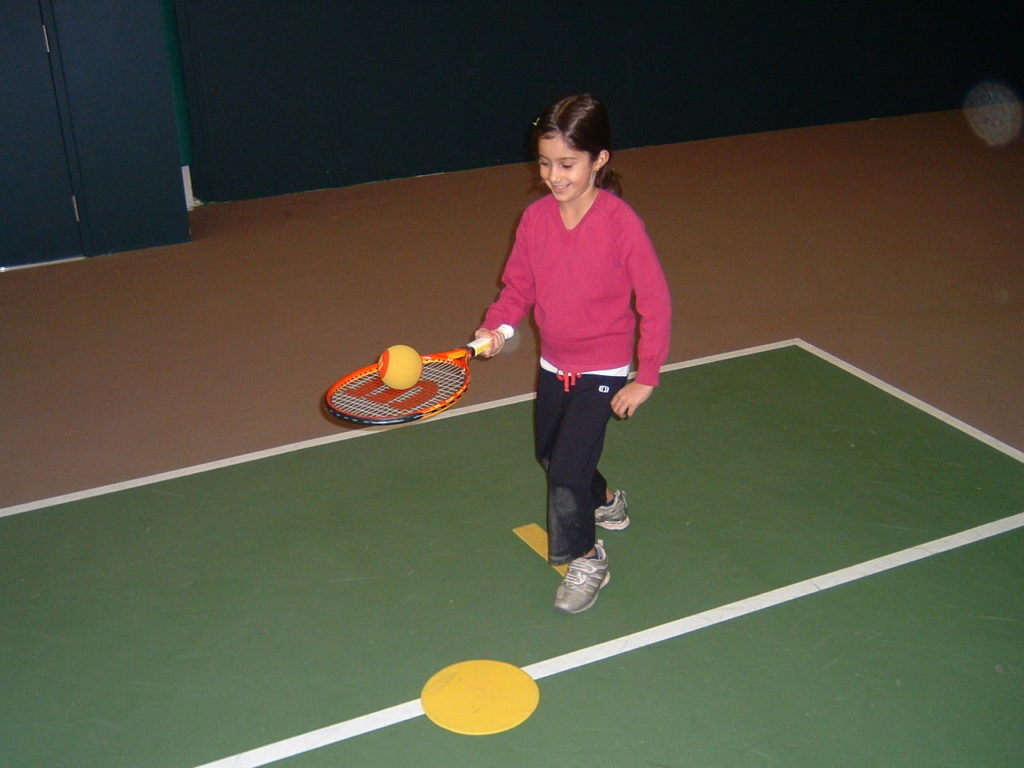
INTRODUCTION: FOUNDATION BUILDING
The Red/Orange/Green (ROG) system of scale-appropriate racquets, courts, balls, and competition, gives tremendous advantages for developing the foundations of tennis. This article will focus on developing 6-8-year-olds on a Red Court.

Even though this article is in reference to Red Ball players, the same philosophy and methodology could be used with starter Orange, Green or even adult & wheelchair players.
Before starting the development process, it is important for a coach to decide the methodology they intend to use. Why is this significant? Because every path a coach takes has different consequences on the learner. Most coaches realize that the game has changed. This has lead to the ‘stuff’ they coach being different (e.g. modern techniques). What is less known, is the process of coaching has also evolved as the ways people learn and process information is researched.
Traditional tennis instruction started with the philosophy of ‘teach the basic strokes’. The first lesson would start with an idealized model of the forehand that the coach demonstrated and everyone copied. The goal of the lesson was to conform students to the model of the stroke. Unfortunately, even with Red Ball Tennis, and all the unique opportunities it contains, many coaches just do the same old stroke lessons but with a different ball on a different court.
All the new information, coming from the best coaching practices, from the top tennis nations, point to other methods that are far more effective (in contrast to the one described above).
The first key principle to keep in mind is what is called the ‘Integrated Approach’. This is understanding that we are developing a whole human being, not just their tennis skills. The Integrated Approach deals with two key aspects, the ‘performer’ (Their psychological and physical components), and the ‘player’ (their tactical and technical components). An effective Red Ball Program provides a phenomenal opportunity to lay solid foundations for all ‘4 Performance Factors’ (psychological, physical, tactical, technical).
The next principle is that tennis is an ‘Open Skill’. It is not robotic stroke movements that make successful players but being able to adapt to situations.
The final principle is using a Game-based Approach (GBA) which looks at learning the tactics and techniques of tennis from another angle. It is not about strokes, but rather connecting the tactics and techniques of play. The philosophy is not ‘teach the basic strokes’ but ‘play the game’, and help players learn the tactics and techniques to play more successfully (which includes strokes).
We will outline the foundations beginning players need to learn tennis in an Integrated Approach, as an Open skill and with a Game-based Approach.
DEVELOPMENT BLOCKS
When developing a 6-8-year-old player, it is important to balance having fun playing tennis as quick as possible, and a long-term perspective of laying the groundwork for all future development.
This balance can be accomplished by adhering to 4 developmental building blocks which are designed to get players quickly to the International Tennis Federations’ (ITF) tag line for the goal with starter players, Serve, Rally and Score as well as building a solid foundation.

Insights into the blocks:
- Blocks 1 & 2 are foundational to Blocks 3 & 4. The ‘Performer’ is the priority.
- Block 1 is woven throughout as the other blocks are used.
- When working in Blocks 3 & 4 and developing the ‘player’, a coach can choose which skills from each block are required to improve the player.
- Blocks 2, 3 & 4 do not have to be developed in order. In other words, one block does not have to be mastered before the next is started. Flip-flopping from block to block (rather than learning in a linear progression), is actually more conducive to how children learn. (See the ‘Accordion method’ section at the end of this article. )
BLOCK #1: F.A.M.E: (FOCUS/ATTITUDE/MOTIVATION/EFFORT)
Goal A: To like tennis
Goal B: To focus on a task
Goal C: Be open to learning and applying effort
A person’s mindset (even if they are 6 years old) will strongly influence the duration and quality of their engagement. Often, younger players have no choice and are thrust into tennis by their parents. This is not a problem unless the player is there reluctantly. If they are not soon ‘won over’, to the point they at least are willingly participating, it will cause major issues with the development process. No child learns correct technique when they are expressing, ‘I hate tennis!’. They will leave the sport, it’s just a question of when.
The key is to make a stimulating environment (which includes a caring coach) so a player moves from just trying tennis, to actually liking tennis. Once they are progressing motivationally, the next goal is to have them be able to focus their attention on a task. Focus (actually continually re-focusing) is the primary mental skill needed for tennis. In order to track, move, and time centering a flying ball solidly on a racquet, focus is essential.
The environment created by the coach must also encourage and inspire players to display a good attitude which, we will define as one that is open to learning so the coach’s feedback can have maximum effect. In addition, they need to be willing to apply the appropriate effort since sport takes effort. The coach must keep in mind what would be reasonable levels of all of these for a 6-8 year old however, as every experienced coach knows, without these elements, skill development becomes a lost cause.
Without focus, an attitude that is open to learning, internal motivation, and a willingness to apply effort, skill development is a lost cause
BLOCK #2: ATHLETIC ABC’s
Goal: Tennis-specific physical literacy
One important rule for effective long-term development is, “Before you develop a tennis player, you must first develop an athlete”. A solid foundation of athletic skills that include running, throwing, catching, jumping, etc. is invaluable for future success in tennis. This is often called, ‘physical literacy’.
An easy way to remember the most important elements is by calling them the ABC’s of athletic development:
- Agility
- Balance
- Coordination
- Speed
There is plenty of literature and videos on this kind of development. It should be included in every session of a child’s training. A very common misconception of coaches and parents is that this training is a waste of time and, time could be better spent hitting more tennis balls. This couldn’t be further from the scientific reality of development for the various ages and stages. Spending time on this will actually make the technical stroke training flow, and progress faster.
Before you develop a tennis player, you must first develop an athlete.
BLOCK #3: TRACKING, CATCHING &THROWING SKILLS
Goal: To be able to play ‘Throw Tennis’
This is a critical, mostly misunderstood, and underused block however, it is an important starting point for the tactical and technical development of the ‘player’.
Most older players and adults can play Red Tennis with little or no instruction. Unfortunately, for most 6-8-year-olds, they cannot. Playing full Red Tennis is something that takes weeks (sometimes months) to build up to. This block is the beginning solution to that issue.
Throw Tennis is rallying (exchanging the ball back and forth) and even serving (overhand throw) without a racquet. This allows development of perception, reception, and understanding how to feed the ball to a partner for future practice (If players learn to send the ball to each other, they dramatically increase the potential repetition in group practice).
It can also be a vehicle to improve bodywork and other technical fundamentals by having players throw the ball in specific ways (e.g. be sideways, rotate your body through the shot, etc.)
Also, in Throw Tennis, players can start the point with an overhead throw which opens the door for points to be played and develops a foundation for the serve. Finally, players can learn to score. For Red Ball players, we can simplify scoring from regular tennis scoring to just tracking points (1, 2, 3, 4, etc.)
Throw Tennis with its movement and control of the ball is actually closer to actual tennis than having a player standing statically, having the coach feed them the perfect ball, and learning how to ‘swing properly’.
The key to remember is, ‘Throw Tennis is tennis’ where players can quickly get to the goal of Serve, Rally & Score.
Playing the game through Throw Tennis
In traditional coaching, the first step is typically to learn the forehand. In a GBA, tactics come first, and the first tactic a player needs for success in tennis is to keep the ball in play consistently. Tennis is a game of errors.
Traditional coaches would typically use basket feeding to introduce the forehand technique. In a GBA, players are most often in ‘live ball’ situations exchanging with each other. Basket feeding is used in a GBA, but not for developing beginner rally skills.
A traditional coach might modify the feeding (feed by hand) to simplify the skill if the students (who would typically be placed on the baseline) were having trouble. As a further simplification, some coaches may place them on the service line (commonly, they would still aim for sending their strokes anywhere into the opposite full court).

The main points of emphasis would be the stroke techniques involved in performing the whole swing shape. The techniques would be ‘chained’ together in sequence (first preparation, contact, then follow-through, etc.).
By contrast, in a GBA, the game would be scaled down to whatever level is required for the players to experience success and tactics would be the foundation. Keeping the ball in play (consistency) as mentioned, would be the first tactic. During Throw Tennis, this tactical goal can be retained. Going further, even before they can handle a racquet, through Throw Tennis, players can understand the ‘meta-tactics’ of space (e.g. recovery, cross courts verses down the lines, etc.), and time (e.g. how the trajectory of the ball can take away or gain time) as well as other tactical elements (yes, I am talking about 6-year-olds).
Through Throw Tennis, players can get their first experience of Serve Rally & Score.
Throw Tennis is tennis, where players can quickly get to the goal of Serve, Rally & Score.
BLOCK #4: RACQUET/RALLY SKILLS
Goal A: Play ‘Floor Tennis’
Goal B: Rally Progression
Goal C: Throw-serve progression
In this block, the player starts to get used to handling the racquet. The key technical fundamental in this block is timing. The definition of timing is: ‘Centering the ball on your racquet in an ideal relationship to your body, for the shot you intend to hit.’
In addition, players learn to have a stable racquet through the hitting zone and controlling the ball. The first goal is playing ‘Floor Tennis’ which is when players push the ball along the ground to each other. Through this, tactics are maintained and technical elements can be improved (e.g. like body position grip, etc.).
The next goal is to have players go through a rally progression. Which includes:
- Step 1: Rally with self
- Step 2: Rally with a partner, short distance, no net
- Step 3: Rally with a partner, short distance, over a net
- Step 4: Increase the distance players are apart
Through these exercises, players continue to improve their technique.
Although players engaged in rallying in Throw Tennis as well as Floor Tennis, it is important to mention some important points about developing a player’s ability to rally. This block may not be first but, it is an important one.
Opening the door to tennis
For any starter player, the first and biggest hurdle to get over is to rally. Exchanging the ball is a huge part of the fun of tennis. Not being able to rally kills the fun. Once a player can rally (even if it is a few shots), the door to the world of tennis opens up. Many people, when they say they are going to play tennis often don’t mean to play points but, to have fun and get exercise by exchanging the ball back and forth. Therefore, to open the world of tennis up to anyone, the first step is to learn to rally.
The secret to rally development is to understand that a rally is an equation:
Br = Bs (Ball Received equals Ball Sent)
It is a neutral exchange. There is a reception and a projection that are both of equal importance
The ‘glitch’ that occurs in traditional coaching is the inequality of the reception compared to the projection. Typically, the coach sends a ball that is easy to receive (sometimes being so accurate with their feed that they actually hit the player’s racquet). The player, on the other hand, is encouraged to whack the ball anywhere into the court.
The challenge is, this inequality transfers poorly when the player goes into the ‘real world’ and tries to rally with partners. In reality, the starter players should develop their reception skills more than their projection to truly gain consistency.

To ease into learning how to rally, players need to exchange the ball in the lowest pressure and simplest situation available. This would be for a player to rally with themselves (Self-rally) and then progress through the other step of the rally progression from there.
The task of self-rallying is used to help players learn how to organize themselves around the most important moment of any tennis shot, the Impact Point (timing). Self-rally allows for easier development of:
- An ‘ideal’ Impact Point (waist level, slightly out front, comfortable distance from the body)
- Body position (sideways with a neutral stance is recommended for starter players)
- Adjustment steps to maneuver around to create the ideal Impact Point
- Racquet work to control the ball’s height, direction and speed
A groundstroke self-rally drill would consist of the player continuously tapping the ball up after it bounces on the ground (usually sending it just above head level to anticipate the future skill of sending the ball up and over the net).
Notice the contrast to traditional stroke coaching. Rather than ‘chaining’ the skill in sequence (preparation, hit, follow-through), the groundstroke skills (both FH & BH) would be ‘shaped’ from the impact point. (e.g. “Here is how you must adjust your feet to organize yourself around a good impact that is at waist level, slightly out front, and a comfortable distance from your body”.)
THE ‘ACCORDION’ METHOD OF SKILL DEVELOPMENT
The Skill Blocks build on each other however, coaches should avoid doing the first block completely then the next, then the next, etc. The goal is to have players engage in play quickly.
Coaches should ‘flip-flop’ back and forth between having players play the game (serve, rally, score or simply exchanging at the initial levels), improving skills by applying Skill Block activities and return to playing. This going in and out from play, to practice, to play, is what I call the ‘Accordion’ method.

For example, a coach may be observing the players playing points. The coach observes they are all having a challenge with their consistency due to difficulties with a stable, laid-back wrist. The coach could then gather the players for an exercise to improve that aspect of their technique (e.g. Block #4: Floor Tennis: Rolling the ball along the ground with the proper grip, out-front impact and sideways body position). After the exercise, they would return to play and incorporate the improved technique.
Or, the coach observes the same consistency challenge but, due to the fact they are not recovering to the proper location. The coach could then do a Block #3: Throw Tennis activity emphasizing recovery. By taking the racquet away, the players can focus on the recovery more easily.
Using this method speeds a players’ progress by maintaining the fun of play. It also speeds learning by ‘Chunking’ skills into bite-sized pieces that are easily assimilated. Chunking is a way of sequencing skills in harmony with the way children learn. If a skill is learned, practiced a little, and then left (to do other things), the skill is like a seed that germinates in a child’s body. This is more effective than spending a long period on one skill.
Are we missing something?
An astute coach may say, “Hold on, isn’t there a missing block? Shouldn’t footwork be a block as well?” The answer is, footwork isn’t a separate skill development block. It is so important that it is in every block (even the proper attitude/effort to run for a ball is a Block 2 element). All skills Should include footwork since tennis is a game of movement.
CONCLUSION
We have explored the main concepts, principles and development blocks to get 6-8-year-olds experiencing the fun of tennis quickly while developing a firm tennis foundation. This process is quite different from the traditional ‘ball feeding’, ‘stroke coaching’ method coaches have commonly employed however, it is much more effective.
Excellent.
😀❤
Outstanding, revolutionary to me on my perceptions towards coaching…
Hi Wayne,have just read this article above .It is so simple very relevant to teaching all levels of players. So many key areas and highlighted . I am going to reread it but have already learnt so much !! You are an exceptional coach and have decided to read one article a day from your excellent library of resources ! Have a great day ian from the rock !